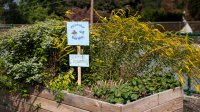Using PBL to Build a Strong Learning Community
A grade-level project-based learning unit provides academic and social benefits as students work both in small groups and as a whole class.
Your content has been saved!
Go to My Saved Content.By its nature, project-based learning (PBL) has a reciprocal relationship with community building; PBL fosters community among learners, and a strong learning community is necessary for successfully implementing PBL. Beginning with generating project ideas and all the way through to completing and presenting a project, PBL requires collaboration and negotiation.
Community-building creates a learning environment where all students feel safe collaborating and contributing. There are both social and academic benefits to a strong learning community. To start, the foundation of a safe community allows students to take academic risks and feel comfortable facing new challenges, which can shape and contribute to learning experiences. Students must practice good communication as they navigate new learning experiences. There’s an abundance of growth in trying something new together.
Gathering data on PBL, engagement, and collaboration for my dissertation project, I collaborated with teachers at a small elementary school in the Shenandoah Valley of Virginia as they implemented my PBL plan for three fifth-grade classes to work together to build a pollinator garden on the school grounds. This grade-level project provided a habitat for pollinators and offered an opportunity for community-building among the three classes.
A Grade-Level Project
We worked on our project during spring 2021; schools in the district had reopened but social distancing limited collaborative learning experiences. Despite the limitations caused by Covid-19, the fifth-grade teachers were creative in finding a way for students to collaborate on a grade-level project, rather than limiting them to the students in their homeroom class.
Having the project outside and letting the students partner and work together laid the groundwork for a beautiful pollinator garden and a community of learners. Social interaction with peers is critical to learning, and social learning experiences contribute to increased student engagement.
Each of the three classes had a different focus (bees, other pollinators, native plant species) within the larger project, but students were encouraged to communicate and collaborate frequently during each phase of the project. One class focused on bees—plants that would attract specific species, along with their food, water, and habitat needs. This group also prepared sites within the garden for beehives that would be added to the garden in the coming year.
The second class focused on attracting other pollinators, such as butterflies and hummingbirds, again focusing on plants that would attract the various species, and their food, water, and habitat needs. Lastly, the third class focused on native plant species that would sustain the pollinators across all seasons. This class started plants from seeds in addition to planting a variety of larger, established plants.
These were the phases of the pollinator garden project:
- Researching various pollinators and plant species native to the region
- Planning/designing a habitat that would provide food and water, shelter, and reproductive needs in all seasons
- Building, painting, and planting
- Culminating project—documenting the project for the school website
While the teachers guided students and facilitated the project, keeping students focused so that they could complete the project within the two-week time frame, each part of the project (research, design, implementation) was student led. Students selected and researched the part of the project that interested them but were able to contribute to more than one part of it.
Students also chose the peers to work with in pairs and small groups to paint bird houses, build butterfly houses and bee habitats, and plant a multitude of native plant species. They worked in groups most of the time, but many completed smaller individual projects, such as painting a clay pot and selecting the plant for it.
Benefits of Student-Led PBL
Student-led PBL means that students came together over common interests and learned from each other as they took on different roles. They were able to support one another as they worked through each phase of the project. Student-led learning experiences provide opportunities for students to take initiative and ownership over their learning.
PBL instruction offers students many benefits, and this project fostered collaboration and community building, increased engagement, social learning, creativity, problem-solving, critical thinking, student choice, and project management skills, to name a few.
At a time when social distancing and separate learning experiences were the norm, it was beneficial for the students to participate in an inclusive project that incorporated the entire grade level. The students embraced this project. They even found ways to extend it beyond the original plan by painting smooth river rocks to place in the garden, to leave a little token of themselves behind at their elementary school before moving on to middle school. The project took hard work and collaboration, and each rock left behind was like a signature of the project the students completed as a community.
